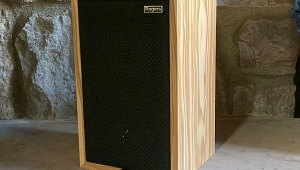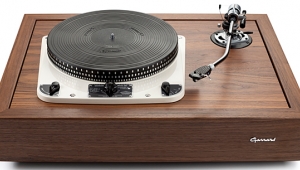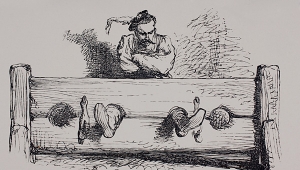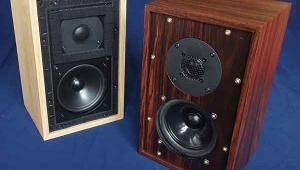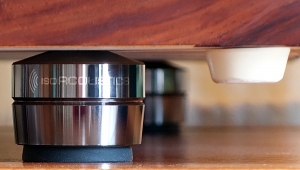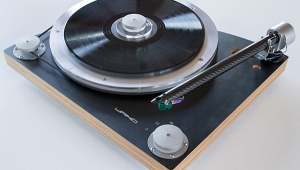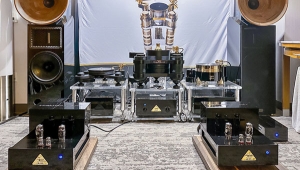| Columns Retired Columns & Blogs |
Listening #67 Page 2
My review sample of the EMT 997 was built with an international connector, allowing me to use it with a variety of pickup heads. Some of those were marginally familiar to me—such as the Ortofon SPU Classic (which I'd tried with a Thorens turntable and Ortofon tonearm) and the EMT TSD 15 (a variation on the common EMT MC motor we all know and love, built more or less permanently into a basic EMT headshell). Others were completely new in my experience, such as EMT's astounding OFD 25 mono pickup head: a high-output, high-impedance, very-low-compliance device with a cantilever shaped like a gardening tool, and able to pull more drama, impact, color, and sheer juice out of a monophonic groove than anything else I've ever heard.
Footnote 2: Distributed in the US by Venus Hi-Fi of East Lansing, MI. Tel: (517) 881-7753. Web: www.venushifi.com.
Yet the vast majority of phono cartridges that you and I have used over the years are the kind with a pair of mounting holes spaced 0.5" on center, and no headshell of their own. Those, too, can be used with the EMT 997, but not without added effort or expense: The 997 is not supplied with a universal headshell, perhaps under the assumption that most record enthusiasts who might want such an arm will tend to use it with old-style pickup heads. If you buy an EMT 997 to use with your Miyabi, Brinkmann, Denon, or other such cartridge, you must also buy one of the many aftermarket universal headshells available, such as the Yamamoto HS-1A ($90, footnote 2), which is machined from solid ebony. After giving up on finding my old Monster Cable Orsonics headshell—apparently a hot item on eBay these days, along with everything else I once owned and have since misplaced—I bought a Yamamoto, which I very much enjoy using.
Here's where things get a bit complicated: The EMT 997, as I've said, was engineered with an effective length of 307mm, comprising a mounting distance of 297mm plus an overhang of 10mm. Its armtube is shaped with a gentle radius at its center, which straightens out again near the headshell collet (as you'll see, that's important). The 997's geometry is such that the playback stylus must be precisely 32mm from the frontmost edge of the armtube: Do that and you'll achieve absolutely perfect alignment, with nulls at 57.5mm and 107mm from the spindle, and well under 2° of error everywhere else.
All of EMT's own pickup heads are engineered such that their stylus points are 32mm forward of the armtube. All of Ortofon's original A-style pickup heads—the cool-looking squarish ones—are engineered that way, too. If you buy an EMT 997 arm and drill its 20mm mounting hole exactly 297mm from the center of the spindle, you'll automatically achieve perfect alignment with any of those pickup heads. For the remainder of what I'm certain will be a very happy life, the only things you'll have to adjust will be downforce and arm height.
But I don't think there's a single headshell on Earth with enough clearance at its bayonet end for getting the stylus of a standard cartridge even close to 32mm from the front of the armtube: It's an almost impossibly tight fit. EMT loaned me a sample of their own accessory headshell for the 997 ($400, which is a mite steep for what it is), but the only cartridge I had on hand that would fit in it was EMT's own TMD 25, which has flying-lead signal connections instead of output pins, and is thus a lot shorter than average. And even that took some fiddling.
The alternative is to mount the base of the EMT 997 an extra 18mm from the spindle—a mounting distance of 315mm, in other words—then move the stylus forward by the precise same amount, thus maintaining the same geometry overall. The overhang remains as it was (if the offset angle could be adjusted—lessened, in fact—the radius of the stylus's arc could be somewhat increased, and the overhang reduced by a very small amount), and the effective length is made even greater: 325mm, or about 12.7".
Here's some more good news: As it happens, the stylus-to-armtube dimension of Ortofon's elongated G-style pickup heads, which include most of the SPU range that's still in production, is 18mm longer than that of the A-style pickup heads (32mm + 18mm = 50mm). Thus, if you mount an EMT 997 tonearm 315mm from the spindle and equip it with any modern Ortofon SPU—or if you fit your accessory headshell with any standard cartridge, making sure to position its stylus tip precisely 50mm from the front edge of the armtube—you'll automatically achieve the best tracking geometry of which the EMT arm is capable. And that's arguably better than most, if not all, other pivoted arms on the market—again, by dint of sheer length.
So then: You can drill the 997's mounting hole exactly 297mm from the center of the spindle, for use with EMT pickup heads and the increasingly rare Ortofon A-style SPU. Or you can drill the mounting hole 315mm away from the spindle, and use the EMT tonearm with Ortofon's elongated G-style pickup heads—or virtually any low-compliance standard-mount cartridge you want to try, given an appropriate headshell.
Or you can do what I did, and achieve both geometries with a single installation: Keith Aschenbrenner has created an accessory mount, price to be determined, that's derived from the tried-and-true SME "locking slide" mount of years gone by: Used with a tonearm board in which an SME-standard elliptical hole has been cut, Aschenbrenner's mount allows the EMT 997's mounting distance to be varied at will over a 25mm range. I've set mine up in such a way that I can go from a mounting distance of 297mm to one of 315mm in just two minutes, with no apparent compromise in rigidity. And it looks cool.
One more installation note: In addition to being long or wide enough to accommodate such extraordinary mounting distances, your mounting platform must also have room for the 2.25" alloy output-jack plate supplied with the EMT 997. (I had fine results on my ">Thorens TD 124 Mk.II with the extended armboard offered by Schopper AG; turntables from VPI, Spiral Groove, and various other manufacturers should also work well.) Some soldering is required, of course, and interconnect cables are not included.
Setup
In use, the EMT 997 sports one large, adjustable counterweight, plus one of two different outrigger weights: 40gm or 80gm, the choice determined by the mass of the pickup head or cartridge-headshell combination. Although there's no simple way to test such a theory, I wonder if the position of the outrigger weight—it threads into place between the bearing housing and the main counterweight, pointing away from the record spindle—is intended to neutralize whatever twisting force may be exerted on the bearing set as a whole by such a long, offset armtube.
Once the pickup head is in place, the user must adjust the 997's main counterweight until the armtube floats on its own, with the stylus tip more or less at the level of the record: easy to do, as it turned out. Then the main counterweight is locked in place with a setscrew, and the downforce spring is applied using a sliding lever on the inside edge of the upper bearing housing. The accuracy of my sample's downforce scale, which is marked from 0 to 5gm in 0.5gm increments, was good enough to rely on as a starting point, although fine-tuning by ear remained the best idea, as it always does.
Footnote 2: Distributed in the US by Venus Hi-Fi of East Lansing, MI. Tel: (517) 881-7753. Web: www.venushifi.com.
- Log in or register to post comments


